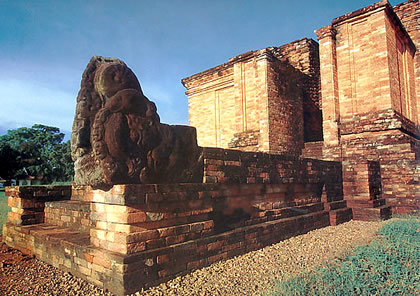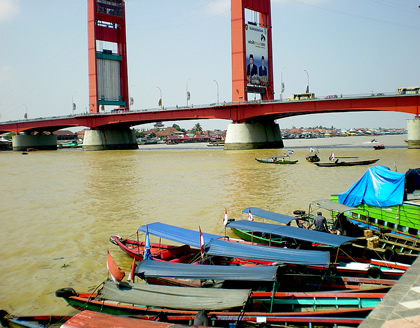 |
| Burma |
The
classical civilization of Burma (Myanmar) is centered at Pagan. After the collapse of the Pyu state, the Mrammas (Sanskritized Brahma), or Burmans, founded their chief city, Pagan (Arimarddanapura or “City Where Enemies Were Exterminated”) around 849 c.e. The ethnic Chinese had pushed them back around the second millennium b.c.e. from Northwest China to eastern Tibet, after which they moved to Myanmar over several centuries.
The first Burman center developed in the rice-growing Kyawkse Plain at the confluence of the Irrawaddy and Chindwin Rivers. According to the local chronicles, Pagan began as a group of 19 villages, each having its nat, or local spirit, which were later fused into a cult of a common spirit. Burmese legends speak of intrigue and bloodshed in the early Pagan history until the emergence of King Anawratha, or Aniruddha (1044–77).
Aniruddha conquered the Mon country of Thaton in 1057 c.e., resulting in an infusion of Mon culture into Pagan. He maintained friendly contact with King Vijayabahu of
Buddha, which was enshrined in the
Shwezigon Pagoda. Pagan was brought into the maritime trading network linked to the eastern coast of India.
Along with the Mon monk and scholar Shin Arhan, Aniruddha was responsible for spreading
Hinayana Buddhism among his people. This quickly spread all over Myanmar and eventually to mainland Southeast Asia. Aniruddha also is credited with constructing a large number of pagodas, including the Shwezigon Pagoda. He visited the
Bengal region and married an Indian princess. Aniruddha developed the small principality of Pagan into an extensive kingdom, and a distinct Burmese civilization grew based on Mon literature, script, art, and architecture.
The second prominent king of Pagan was Thileuin Man (Kyanzittha), who ruled from 1084 to 1112. He crushed the Mon uprising that had claimed the life of the earlier king’s son and successor, Man Lulan, and made peace with the rival Thaton faction of the Mons through matrimonial alliances.
The Thervada monkhood flourished under his patronage. He even fed eight Indian monks daily for three months. Having heard about Buddhist monuments like the famous Ananta Temple in the Udayagiri hills of Orissa, he constructed the magnificent Ananda Temple in imitation. Kyanzittha also visited Bodhgaya and helped repair Buddhist shrines.
He tried to bring assimilation of different cultural traditions prevalent in Myanmar, and the Myazedi pillar of 1113 c.e. had identical inscriptions in four languages: Burmese, Pali, Pyu, and Mon. He sent a mission to China, which recognized the sovereignty of Pagan.
The transition from Mon to Burman culture occurred during the rule of the grandson of Kyanzittha, Alaungsithu (Cansu I), who had a long reign from 1112 to 1165. He undertook punitive expeditions to Arakan and Tenasserim. Relations with Sri Lanka deteriorated over interference with trade between Angkor and Sri Lanka. Alaungsithu nurtured Buddhism and completed the imposing Thatpinnyu Temple in 1144.
The last of the important kings of Myanmar was Narapatisithu (Cansu II, 1174–1211), who ended the Mon influence in the Pagan court. Relations with
Sri Lanka improved, resulting in the end of the friendship of Burmans with Colas and a promise of noninterference by Pagan in Sri Lanka’s trade over the isthmus region. The king also introduced reforms in monkhood. However his successors were unsuccessful, and gradual deterioration started in the Pagan kingdom.
The shrinking of central authority resulted in Arakan and Pegu becoming independent. The Thai people known as Shans began to enter Pagan. There were also subsequent Mongol expeditions against the kingdom. The last king of the dynasty, Narasimhapati (Cansu IV), was a boastful ruler, and his subjects murdered him for his flight during a
Mongol invasion.
Under the leadership of the Shans, the kings of Pagan were forced into a ceremonial role only. The masalah facing Myanmar had been to hold together different ethnic groups, and this was evident in the Toungoot (Tungut) dynasty of the 16th century and the Konbaung dynasty (1792–1885).
The prevalence of Sanskritized names and commercial relations point to the close link between
India and Myanmar. The region was geographically nearest to India among Southeast Asian countries, and there were land and sea routes through which cultural relations developed.
From very early on Indians traveled these routes to Southeast Asia. Cultural intercourse between the two regions grew, probably through traders and Buddhist missionaries reaching lower Myanmar. Adopting Indian practices, women were given a higher place in society, and the caste system was rejected.
Though
Buddhism dominated daily life, it was mingled with Brahmanism. At the site of King Kyanzittha’s palace, naga spirits were propitiated, and the services of Brahmans were required. The king was proclaimed an avatar (incarnation) of Vishnu after his death. The name of one of the early cities of the Pyu people was Visnupura (modern Beikthano), and it was a center of Vishnuite influence.
Images of Brahmanical gods such as Vishnu,
Brahma, and Shiva are found throughout Myanmar. Compared to Brahmanism, the influence of Buddhism in Myanmar was greater. In the Buddhist Jatakas there are frequent references to the sea voyage to Suvarnabhumi, or the golden land, which has been identified with Myanmar. Kings like Aniruddha and Kyanzittha were patrons of Buddhism, and because of their endeavor, the religion took firm roots in Myanmar.














